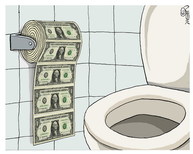Managing the Economy

By the end of this unit you should be able to understand and explain:
- Different types of business organizations
- The organization of production
- How and why firms compete
- The role of government in an economy
- Inflation
- Employment and unemployment
Unit 4 Plan
| economics_unit_4_plan.docx |
The Advantages and Disadvantages of Different Types of Business Organization
The Growth of Firms

Reasons why firms may wish to grow in size
- To diversify and spread risk
- To take advantage of higher levels of demand that exist
- To tap into emerging markets
- To take advantage of changing market conditions
- To take advantage of economies of scale
- To take advantage of globalisation and expand into overseas markets
- To increase market share and develop greater monopoly power
|
Type of Merger
Horizontal Merger Vertical Merger Lateral Merger |
Potential benefits to the firm
|
Economies of Scale
The concept of economies of Scale is a central area in Economics and provides a clear rationale for why firms grow.
Internal Economies of Scale
Internal economies of scale refers to the reduction in AVERAGE COSTS that a firm experiences as a result of increased output by the firm. This is shown on the right:
Between 0 and Q2 the firm is encountering economies of scale. The increase in output has lead to a reduction in Average Costs.
There are a number of types/sources of Economies of Scale:
Internal Economies of Scale
Internal economies of scale refers to the reduction in AVERAGE COSTS that a firm experiences as a result of increased output by the firm. This is shown on the right:
Between 0 and Q2 the firm is encountering economies of scale. The increase in output has lead to a reduction in Average Costs.
There are a number of types/sources of Economies of Scale:
|
Type of Economies of Scale
Financial Economies of Scale Purchasing Economies of Scale Technical Economies of Scale Managerial Economies of Scale Financial Economies of Scale |
Explanation
|
Diseconomies of Scale
Diseconomies of Scale is the idea that it is possible for some firms to become TOO large, such that a rise in output begins to lead to an increase in average costs. This can be shown on the diagram below, where diseconomies of scale set in when output increases above Q2.
Reasons for Diseconomies of Scale:
Reasons for Diseconomies of Scale:
- As the firm increases, factor inputs (resources) become more scarce and hence more expensive
- As the firm grows, communication and decision making becomes more difficult, contributing to inefficiencies and rising costs
- As the firm grows, worker morale and motivation declines as they feel like a “small cog in a big wheel”. This may contribute to reduced productivity and higher average costs
How To Review An Article From The Economist
Competition and Monopolies
Monopoly Basics
What are the Economic Objectives of Government?
There are 4 main macro-economic objectives of Governments. These are:
(1) Economic Growth
· Ideally Economic growth will increase at a steady rate. The ideal rate is an annual rate of around 2.5%
· Economic Growth needs to be sustainable. This means that it is achieved using renewable resources and in a way that is environmentally friendly
(2) Low inflation/Price Stability
· There is an acceptance that in a modern, dynamic economy prices are likely to rise over time
· However high inflation is bad for the economy
· The Government and the Monetary Policy Committee of the Bank of England set an inflation target of about 2-2.5%. They intervene (using tools such as interest rates) if inflation looks like it is going above this target level
(3) High employment/Low unemployment
· Again, it is reasonable that there will always be a small amount of frictional unemployment as workers move between jobs
· However, a key aim of government is to keep employment as high as possible
(4) Balancing imports and exports: avoiding a large current account deficit
· The government must ensure that there is not more money leaking out of the economy (to pay from imports) than is coming into the country from the sale of exports
Clashes between economic objectives
It is often very difficult for a government to achieve all 4 economic objectives at once. For example, in a recession, the government may try and stimulate demand. This will stimulate economic growth and reduce unemployment. However it may also cause demand pull inflation and “suck in” imports, thus making the current account deficit worse
(1) Economic Growth
· Ideally Economic growth will increase at a steady rate. The ideal rate is an annual rate of around 2.5%
· Economic Growth needs to be sustainable. This means that it is achieved using renewable resources and in a way that is environmentally friendly
(2) Low inflation/Price Stability
· There is an acceptance that in a modern, dynamic economy prices are likely to rise over time
· However high inflation is bad for the economy
· The Government and the Monetary Policy Committee of the Bank of England set an inflation target of about 2-2.5%. They intervene (using tools such as interest rates) if inflation looks like it is going above this target level
(3) High employment/Low unemployment
· Again, it is reasonable that there will always be a small amount of frictional unemployment as workers move between jobs
· However, a key aim of government is to keep employment as high as possible
(4) Balancing imports and exports: avoiding a large current account deficit
· The government must ensure that there is not more money leaking out of the economy (to pay from imports) than is coming into the country from the sale of exports
Clashes between economic objectives
It is often very difficult for a government to achieve all 4 economic objectives at once. For example, in a recession, the government may try and stimulate demand. This will stimulate economic growth and reduce unemployment. However it may also cause demand pull inflation and “suck in” imports, thus making the current account deficit worse
Taxation
This part if the unit examines how the government finances public expenditure and the possible effects of different monetary and fiscal policies.
Worksheets
|
|
| ||||||
The Basics of Taxation
Review Materials
|
| ||||
